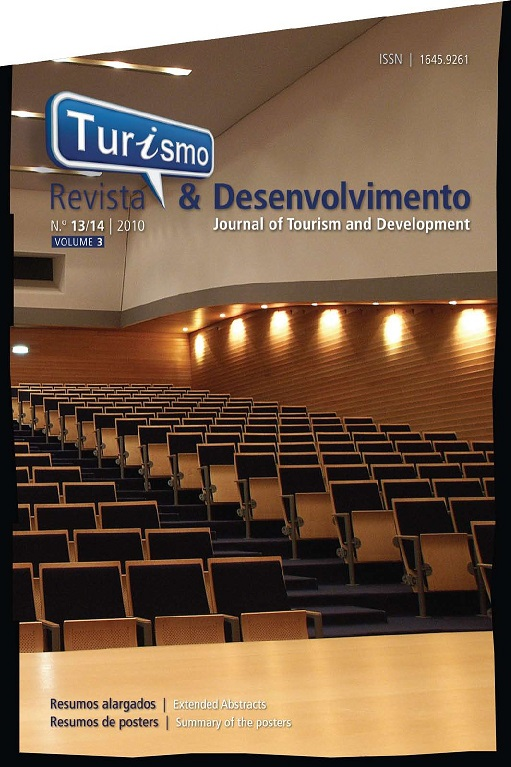Occupational variations in the returns to education and experience in the Spanish hospitality sector: a comparative analysis
Resumo
Objectives | This study analyses the returns to education, experience and tenure for males and females in the Spanish hospitality sector across occupational categories. The motivation of this research is based on the evidence that jobs in this sector are very different and the estimation of these rates of returns for each components of human capital may not be adequate for the sector as a whole. Managers and professionals may require more years of formal education and general and specific on the job-training and enjoy a high degree of job security with internal career paths. However most employees of this sector do not enjoy the labour conditions of the primary sector occupations, but their jobs can be classified as belonging to secondary labor market, characterized by precariousness, low pay, high rates of turnover, high seasonality, antisocial working hours and lack of opportunity for training and career advancement. In this context, this work presents estimates on returns of human capital components of five different occupational categories and compares the obtained results for the hospitality sector with other private sector services. In this way, this work tries to determine if returns on human capital are skewed towards higher-paying occupations such as white-collar managerial job. By estimating separate occupational wage regressions, it is assumed that there are different wages structures across occupational categories; this assumption is valid as long as intragenerational occupational mobility, defined as movement among broad occupational groups along the working life, remains low. This seems to be the case of the Spanish hospitality sector and of the other private sector in the Spanish economy. Therefore, we are assuming that one can explore if workers employed in identical occupations in different industries and services achieve similar rates of returns on education and post-employment human capital acquisition than in other sectors. Finally, because of the main objective of this study is to compare and assess the return to education, experience and tenure for males and females, one should assume that issues concerning unobserved heterogeneity and self-selection across those individuals will not affect comparisons across economic sectors and occupational segments, since with the dataset we are working, it is not possible to solve these problems.
Methodology | Occupations are grouped into four categories. In doing this, we have also considered occupations that are especially relevant in the hospitality sector, and dispose of enough observations in each cell. The four groups of occupation considered are:
1. Managers, professionals, technicians and office clerks
2. Front office service workers, defined as customer services clerks and service and market sales workers (except restaurant services workers)
3. Skilled and unskilled manual employees
4. Restaurant services workers After defining the occupational categories, wage equations must be estimated in order to test whether the return on each component of human capital is lower in less-advantageous categories. The equation is specified as follows: Ln Wi = α0 + α1 Si + α2 Expi + α3 Ti + δi Z + ui Where Ln Wi represents the log of gross hourly earning Si is the number of years of schooling; Expi is experience up to the current position; Ti is time expend in the present firm; Z is a vector of other (i) control variables; ui is a stochastic error term. The controlvariables are:type of labourcontract (permanent or open-ended), part-time,single-employer bargaining,size of firm, and nationality (two dummies, one for EU members residents in Spain and other for immigrants from the rest of the world). In order to establish whether wage equation coefficients differ substantially between occupation categories, an F-test was calculated for each combination of these categories.
Main results and contributions | Our results are still provisional and our paper is not finished yet. Up to this moment, our main results indicate that the rates of returns on human capital are small in the hospitality sector for most occupations when we compare estimates of this sector with other private services sector. Furthermore, in most occupations returns to education are near cero in the hospitality sector. The same results are not obtained for the aggregate of other private services sector. The rates of return on educations for women are always lower than those estimated for men in the hospitality sector. Similar conclusions are obtained analyzing this rate of returns for other private services sector (except for the first occupational group). On the other hand, the estimated returns on experience and tenure show mixed results. In the hospitalitysector, the rates of return on experience for women are always lower than those estimated for men but the results for tenure are not statistically equal in all cases, according to the values of Wald test. In several occupational groups the estimated returns on experience are higher for men in the hospitality sector than in other private services sector (Managers, professionals, technicians and office clerks and Restaurant workers).The same conclusionscan be reached when considering the returns on tenure. For women the returns on tenure in the hospitality sector are statistically higher than for men in two occupational groups (Skilled and unskilled manual employees and Front office service workers). On the other hand, the estimated coefficients of control variables are highly statistically significant – mainly those representing firm size, full-time job and permanent contract –. Thus our preliminary results indicate that in the hospitality sector – except for managers, professionals and office clerks-tenure and jobs characteristics – including type of contract – are the most relevant factors explaining wage determination mechanism. Finally, our study suggests that as differences in the returns on human capital components across occupational categories are statistically significant and large, then the relative weight of each segment within the aggregate hospitality and travel agencies services may explain the results obtained, at aggregate levels, in previous studies.
Limitations | We are not able to control for individual-specific or heterogeneity effect due to the date base used, the Wage Structure Survey (2006), which is a employer survey of firms with one worker or more which contains information of characteristic related to each worker (education, tenure, type of contract, type of job,sector, firm size), but not on people out of the labor market or other information respect to the years since leaving school until the entry into the current firm.
Conclusions | Education, experience and tenure seems to be important for the occupational categories of manager, professional and office clerks in the Spanish hospitality sector mainly, but lower and statistically different from other private services sector. The determinants of the level of individual earnings working in occupations of lower rank status depend more on job characteristic rather than individual’s human capital endowment.





